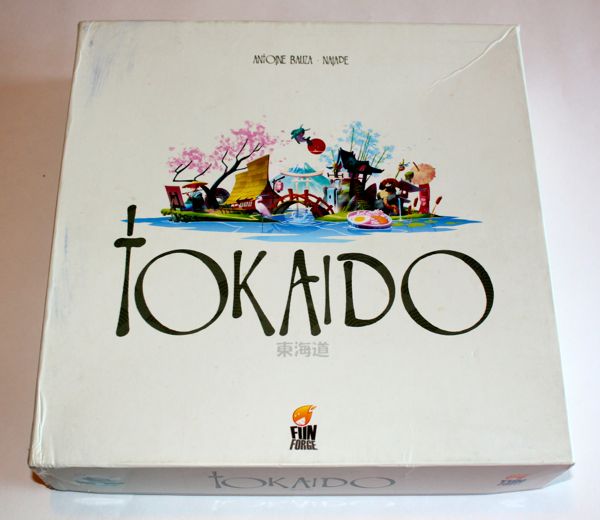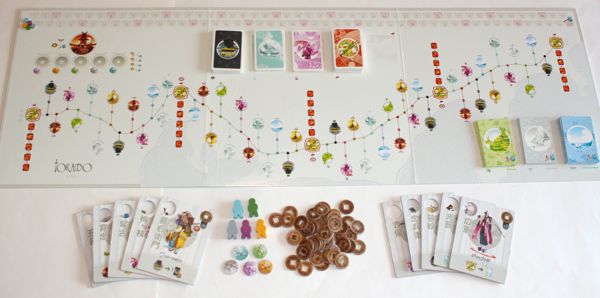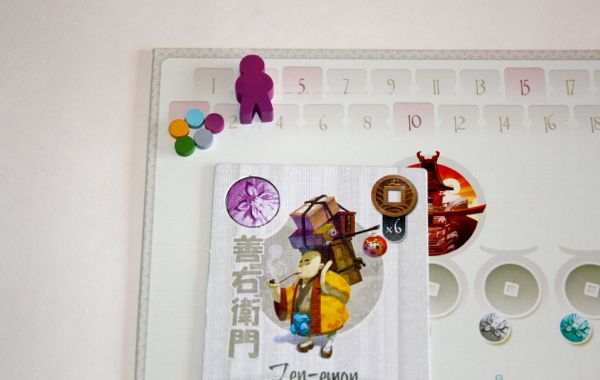
You are about to embark on a journey from ancient Kyoto to Edo (aka Tokyo). The Tokaido Road was the most important route connecting Edo with other parts of the country back in the day.
Your task is mostly to collect the most sets and have the majority of certain items by the time you reach the end of the road at Edo.
If that, combined with the picture of the game board (below) sounds like enough fun to you that you want to get this game now, click here to check the pricing and availability of Tokaido at Amazon.
If you need to have more information before making your purchase, read on.

How Do You Play Tokaido?
You and up to 4 other players all start in Kyoto at the left end of a large tri-fold board. Your human-looking pawns all start at the inn there.
Movement in Tokaido does not involve any dice. Whoever is behind on the path takes the next turn. If that movement still leaves that pawn in last place, that person gets to move again.
Some of the spaces (dots, really) along the route have more than one opening available. You only get to use these extra dots if there are 4 or 5 players though.
When you get to each of the 4 (counting Edo) red inns along the way, you must stop until everyone else catches up with you.
Each of the dots on the route allows you to perform an action. In some cases you need enough money to do so.
These are the action spaces.
Village (souvenirs – black)
You draw 3 souvenir cards and keep 1 of them. You are trying to collect sets of these cards. The larger the set, the more points you get.
Farm (yellow)
You take 3 coins from the supply.
Panorama (green, gray, or blue ocean)
You take a card of the corresponding panorama type and score the number of points on the card.
Hot Spring (blue)
You take a card and score either the 2 or 3 points it is worth.
Temple (orange)
You donate 1, 2, or 3 coins to one of the temples and get that many points.
Encounters (lavender)
You draw a card and do what it says. This is sort of a miscellaneous space that lets you do one of the other actions already mentioned above.
Inns (red)
You can buy a meal card, if you can afford it and if you haven’t had that kind of meal earlier, and score the 6 points it gives you.
The advantage of getting to an inn first is that you get to choose from more cards than subsequent travelers. The last player to arrive only gets to select from the last two cards, which he may not be able to afford or may have already eaten.
The game ends when everyone reached Edo. Then there is some end game scoring based on what you did along the way.
The player to donate the most money to the temple gets 10 points. The second highest contributor gets 7, and the third gets 4. Any others get 2.
- The first player to complete each type of panorama gets 3 points.
- The player with the most expensive meals gets 3 points.
- The player with the most Hot Springs cards gets 3 points.
- The player with the most Encounter cards gets 3 points.
- The player with the most Souvenir (Village) cards gets 3 points.
If there are ties, both players get the points. The player with the most points is the winner. Ties are broken by giving the win to the player with the most cards.
Is There Any Strategy in Playing Tokaido?
There isn’t much. You want to get (or give a lot, in the case of the temple) of everything, but you probably won’t be able to. So you’ll have to try to concentrate on a few of your options.
Your tactics in doing so may often be dictated by what the other players do. If a space you want is filled, you might have to skip over it and hope for another similar spot later, or change your concentration to some other type of dot.
Speaking of dots, besides the lack of many real choices in Tokaido, my biggest gripe is with the size of the scoring markers. The teeny tiny circles are so small that they’re hard to pick up. I think the only reason we haven’t lost any of them is that we haven’t played the game all that often yet.

That said, it probably won’t get played all that much more because there are other games we own that we like a lot better and would choose to play rather than Tokaido.
Tokaido looks very nice, but that’s not enough to make it a great game. It’s a very average game which could become one of your favorites, but it won’t become one of mine. Sorry, Mr. Bauza. (Antoine Bauza designed Tokaido and, probably more famously, 7 Wonders, Takenoko, and Hanabi.)
If you now think Tokaido is for you, check it out at Amazon here.
